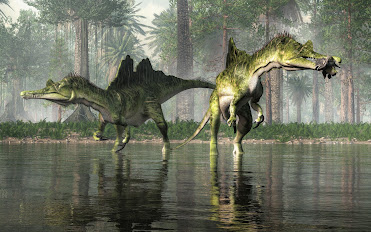Picture an alligator whose legs grew especially long, add a big split sail on his back and arms that could grasp. That's kind of what these big therapod dinosaurs looked like.
The first fossil remains of Ichthyovenator were found in 2010 at Ban Kalum in the Grès Supérieurs Formation of the Savannakhet Basin in Savannakhet Province in the province of Laos. We have found other fossil remains at the site including fossil fish, iguanodontians and some compelling sauropod and ornithopod tracks.
Dinosaur remains are among the fossils that have been recovered from the formation. It is equivalent to the Khok Kruat Formation of northeastern Thailand, a fluvial formation similar in age.
The Khok Kruat Formation is a treasure trove of fossil goodies as well. We have found the remains of fossil sharks, fish, turtles, crocodilians and pterosaurs. Phuwiangosaurus-like teeth, Siamosaurus teeth, and fragmentary postcranial remains of spinosaurids have been dug up there. We have also found Fukuiraptor-like teeth—and, being close in age, they are both Albian, it is likely just a matter of time before we find Ichthyovenator bones there as well.
Ichthyovenator had a long, shallow snout and robust forelimbs. Its diet likely mainly consisted of aquatic prey, hence its etymology. Spinosaurids are also known to have eaten small dinosaurs and pterosaurs in addition to fish.
Ichthyovenator's conspicuous split sail might have been used for sexual display or species recognition. Fossil evidence suggests spinosaurids, especially spinosaurines, were adapted for semiaquatic lifestyles. The vertebral spines of Ichthyovenator's tail were unusually tall, suggesting—as in today's crocodilians—the tail may have aided in swimming. Ichthyovenator lived alongside sauropod and ornithopod dinosaurs, as well as bivalves, fish and turtles.
These fossilized bones were recovered from a red sandstone layer within a surface area of less than 2 square metres (22 sq ft).
So, what did we find? So many great bits and pieces of these giant beasts as a massive jigsaw puzzle. Gathered together, they have been designated under the specimen numbers MDS BK10-01 to 15. There is a partly articulated, well-preserved skeleton. Sadly, missing are the skull and limbs. In with the bits and pieces were the third-to-last dorsal (back) vertebra, the neural spine of the last dorsal vertebra, five partial sacral (hip) vertebrae, the first two caudal (tail) vertebrae, both ilia (main hip bones), a right pubis (pubic bone), both ischia (lower and rearmost hip bones) and a posterior dorsal rib.
The twelfth dorsal spine is bent sideways when viewed front-to-back due to taphonomic distortion. The central (vertebral bodies) of the sacrals are largely incomplete due to erosion but preserved all of their accompanying spines with their upper edges intact.
At the time of Ichthyovenator's description, excavations at the site were still ongoing. Cast fossil spinal column laid out inside a glass display case at a museum
Casts of the vertebrae at the Muséum National d'Histoire Naturelle, Paris
After undergoing preparation in 2011, the skeleton was used as the basis, or holotype, for the type species Ichthyovenator laosensis, which was named and described in 2012 by palaeontologists Ronan Allain, Tiengkham Xeisanavong, Philippe Richir, and Bounsou Khentavong.
The generic name is derived from the Old Greek word ἰχθύς (ichthys), "fish", and the Latin word venator, "hunter", in reference to its likely piscivorous or fish-eating lifestyle. The specific name refers to its provenance in Laos.
Ichthyovenator is the third named spinosaurid dinosaur from Asia after the Thai genus Siamosaurus in 1986 and the Chinese species "Sinopliosaurus" fusuiensis in 2009. The latter may represent the same animal as Siamosaurus.
In 2014, Allain published a conference paper on Ichthyovenator; the abstract indicated additional remains from the original individual had been found after excavations continued in 2012. These remains include three teeth, the left pubis, and many vertebrae, including a nearly complete neck, the first dorsal vertebra, and seven more caudal vertebrae.
Some of these additional vertebrae were compared with those of other spinosaurids in a 2015 paper by German palaeontologist Serjoscha Evers and colleagues, in which they noted similarities with the vertebrae of the African spinosaurid Sigilmassasaurus.
Allain and his team considered Ichthyovenator as representing the first unequivocal spinosaurid from Asia. Though prior spinosaurids had been named from the continent—including Siamosaurus from Thailand's Barremian Sao Khua Formation and "Sinopliosaurus" fusuiensis from China's Aptian Xinlong Formation—the authors noted that palaeontologists have debated the validity of these taxa because they are only confidently known from isolated teeth.
Brazilian palaeontologists Marcos Sales and Caesar Schultz have suggested these teeth may eventually be attributed to spinosaurids similar to Ichthyovenator. In addition to tooth fossils, a spinosaurid skeleton that possibly belongs to Siamosaurus was excavated from the Thai Khok Kruat Formation in 2004 and was identified as a definite spinosaur in a 2008 conference abstract by Angela Milner and colleagues, eight years before Ichthyovenator's description.

